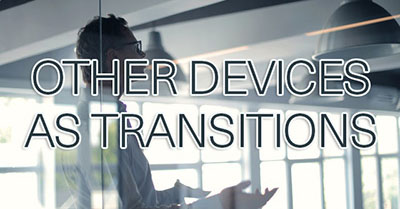Email this series
So far in this lesson, we have looked at how you can use the following to show transitions between ideas:

Image by Andrea Piacquadio | Pexels
Yet, we also find transitions in places other than sentences or paragraphs. Chances are you have come across many of them in just the last few hours even if you were not reading or writing anything.
Other Types of Transitions in Written Materials
Chapters and Headings
As you are reading the information on a web page, you have a sense for the main topic. (The title and introduction generally gives you that information.)
As you keep reading, you will finish one section (which gives you a “chunk” of information). Then there is a heading, which tells you how the next “chunk” relates to the whole page.
In other words, chapters in a book and headings in a passage or web page work as transitions between the ideas in the reading material.
Paragraph Breaks
Have you ever wondered why we write paragraphs instead of simply a block of text? Paragraphs organize information and walk the reader through the information in “chunks.” Yet, sometimes writers choose to break a paragraph where you would not expect.
There is a reason for that!
We are not always aware of the reason, but good writers lay out information on a page purposefully in order to create a message or to convey the information just the way they want..
Have you noticed the paragraph above? It says “There is a reason for that!” I chose to write that one-sentence paragraph to draw attention to the information that was about to come in the following paragraph. That one-sentence paragraph works as a transition, and it does convey information.
Illustrations
In some publications, you are “interrupted” by a large picture or material in large print. You can’t miss it because it is visually appealing and related to the passage.
Good writers often add illustrations purposefully to convey a message.
Many times writers place those illustrations right where they are on purpose. Doing so not only creates a break in the passage visually but also sometimes provides some information that ties what you are reading together.
Have you noticed the large text between two bars above? That was an example of highlighting information purposefully in order to highlight information or create a message. It works as a transition because it connects the information before it to the information that is about to come.
Other Types of Transitions in Spoken Language
We generally learn about transitions in the context of reading and writing; however, you come across transitions in spoken language as well. Of course, we use conjunctions and conjunctive adverbs when we speak, but that is not what I am talking about. We also use transitions in more subtle ways, many of which we detect without even realizing it.
For example, when you are watching a presentation, you sometimes “know” they are about to finish — not because the presenter says so, but because you “sense” that they are about to wrap the presentation up.
How is that possible?
When we are speaking, we use intonation and tone of voice that provide information. Usually, when you are about to finish a presentation, your tone of voice changes; perhaps you slow down a bit because you still have enough time left. The audience picks up on those subtle cues, which serve as a transition between the body and the conclusion of the presentation.
Other Types of Transitions in Music and Film
Music has many transitions. The melody changes tempo and intensity, showing where the different parts of the piece are. The end of a song usually has a change in intensity or volume; sometimes notes get longer. Somehow, we just know where everything is.
The next time you watch a movie, notice visual transitions in the story. They signal where parts of the story are and, when there’s a change between one scene and another, how the new scenes are related to the story as a whole.
For example, imagine a scene where people are talking in a bar late at night. They make plans. Once a dialog ends, You see a beautiful morning scene outside the home of one of the characters. Clearly, the different lighting and mood tells you this is a new part of the story. The information went from those people talking in a bar late at night to the next morning.
Final Words
Wow! The above heading works as a major transition, doesn’t it? It connects not only to this page but also to everything else you have been learning.
When you read, it is important to notice transitions. Good writers use them to help you, the reader, understand the information they want to convey. In a persuasive passage, for example, the writer lays out each premise, and the transitions help you identify and process them.
When you write, use the right transitions to make your ideas easier for the reader to understand. Sometimes a set of ideas is not very easy to follow, but a simple transition shows how the ideas are related to each other or to the whole passage.
At the same time, do not overuse transitions. Find the right balance. The relationship between ideas is often clear enough from the context, so using transitions where they are not needed may be distracting and make your work seem unsophisticated or inexperienced.
Congratulations on completing this material!

Thanks to our supporters!
This material has been made possible by supporters like you. Learn how you can support us.

“What should I learn next?”
Use the buttons below to choose another skill or another lesson in this skill.
Thank you for Supporting Snap Language
Snap Language supporters make the creation of these materials possible.
Learn how you can support our work, get perks, and help us continue creating high-quality materials.
You can support us by simply white-listing this site.